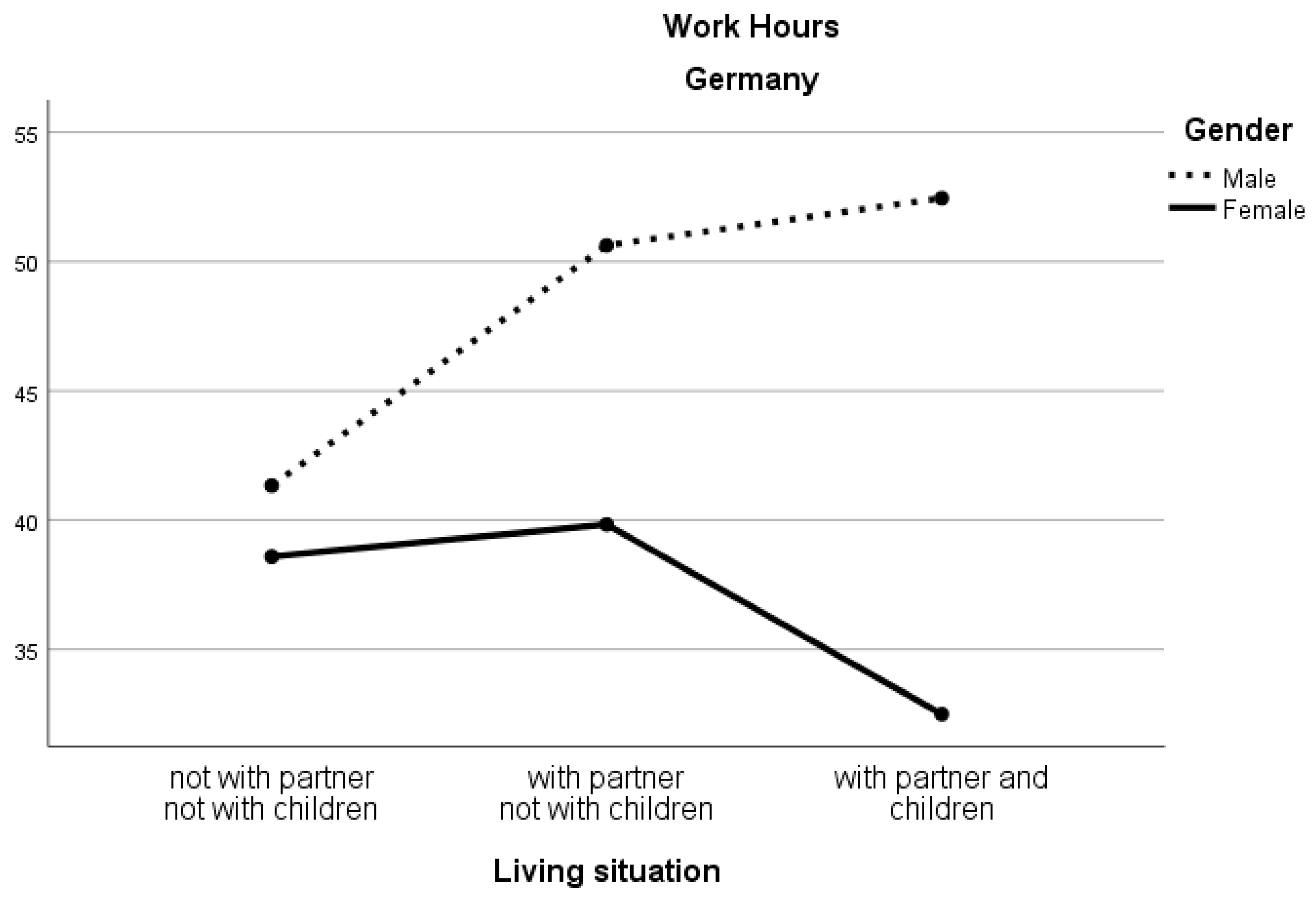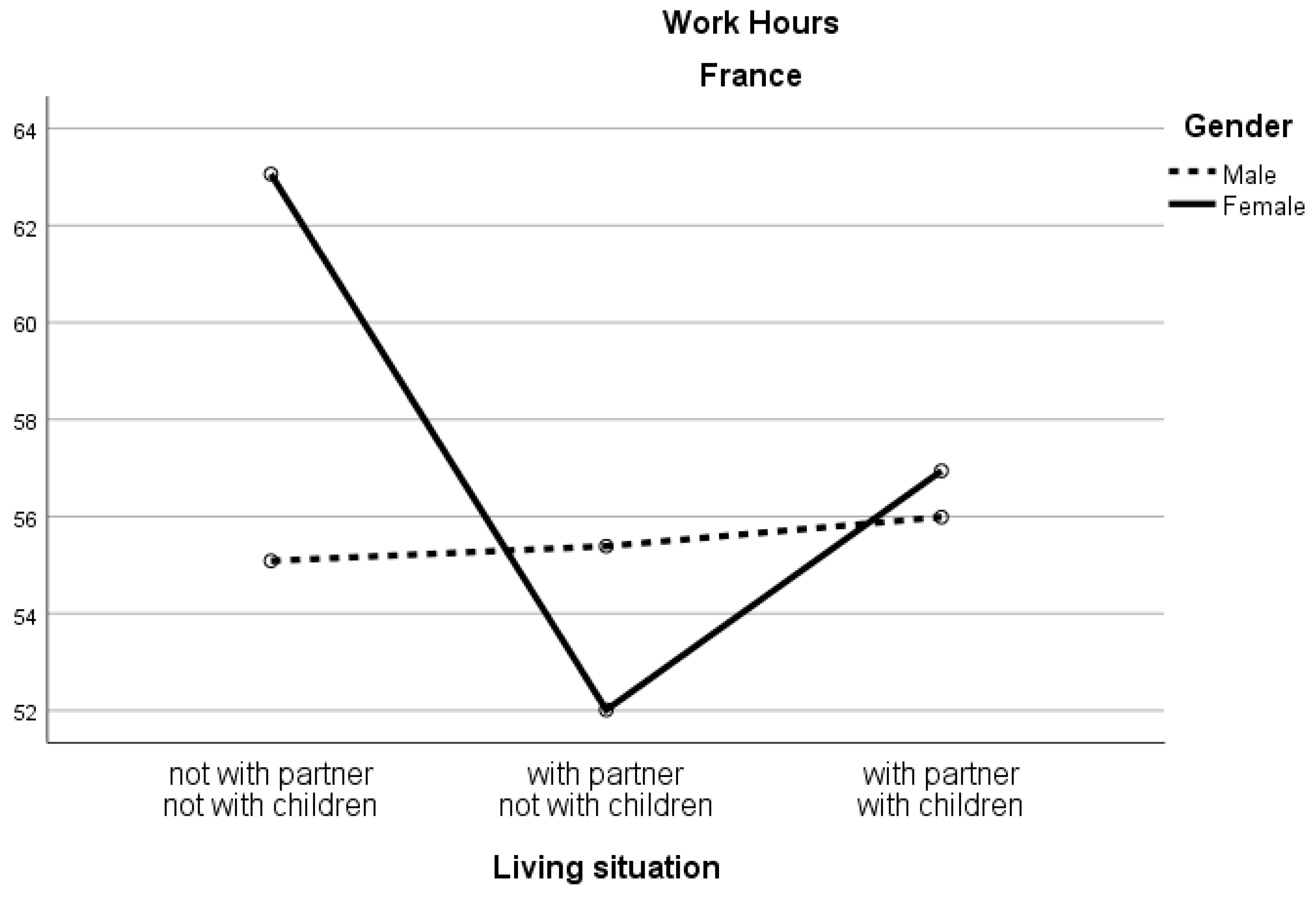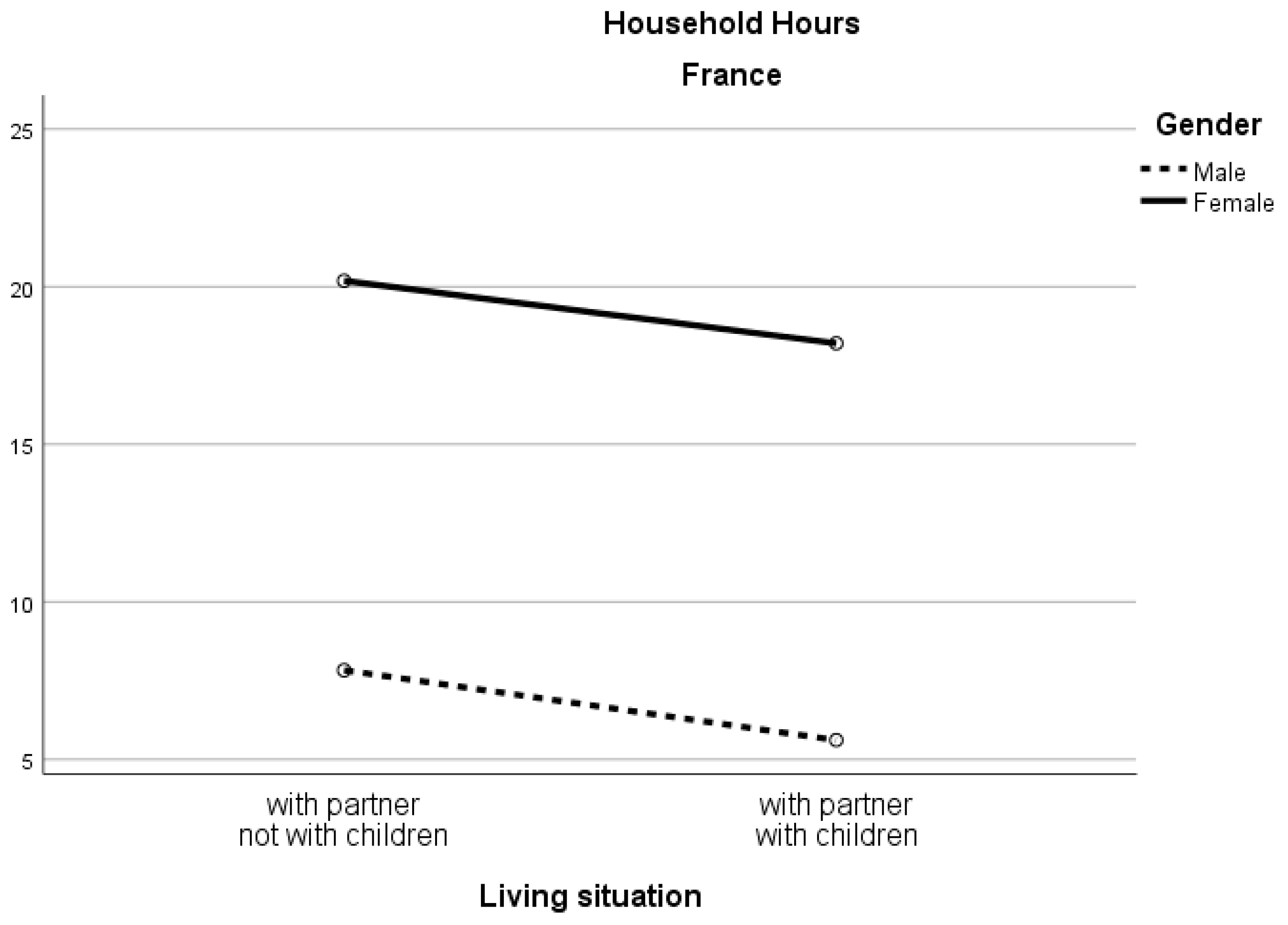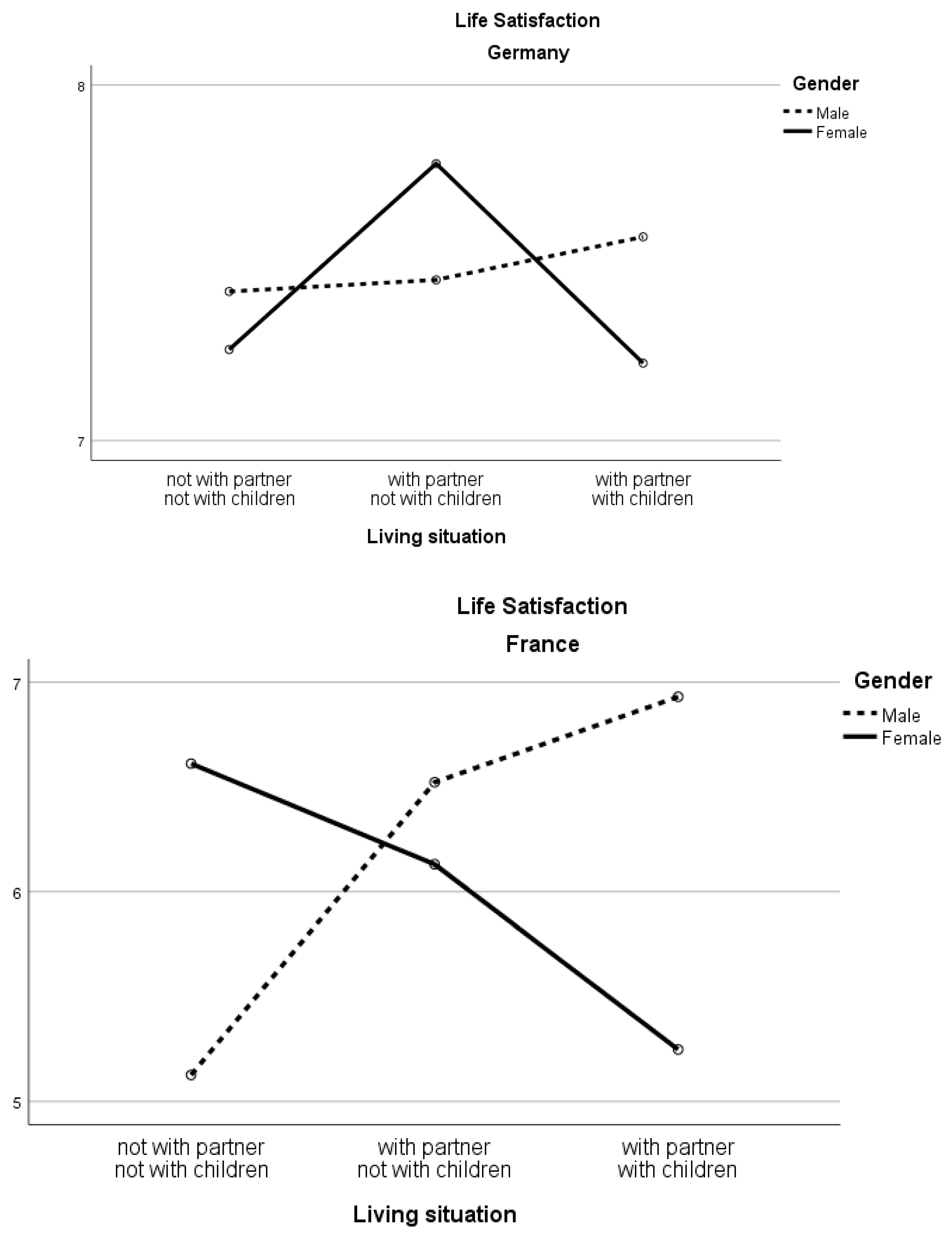Is Female Entrepreneurship Only Empowering for Single Women? Evidence from France and Germany
Abstract
1. Introduction
2. Literature Review
2.1. Female Entrepreneurship
2.2. Context: Germany
2.3. Context: France
2.4. Gender and Living Situation on Work and Household Hours
2.5. Gender and Living Situation on Life Satisfaction
2.6. Gender and Living Situation on ‘Business Success’
3. Methods
3.1. Sample
3.2. Measures
4. Results
4.1. Descriptive Statistics
4.2. Prediction of Work Hours
4.3. Prediction of Household Hours
4.4. Predicting Life Satisfaction
4.5. Number of Employees
4.6. Household Contribution
5. Discussion
5.1. Summary of Results
5.2. Investing in All the Single Women
Author Contributions
Funding
Conflicts of Interest
References
- Ahl, Helene. 2006. Why research on women entrepreneurs needs new directions. Entrepreneurship: Theory & Practice 30: 595–621. [Google Scholar] [CrossRef]
- Ainsaar, Mare, and Kadri Rootalu. 2016. Does marriage and having children make life better in Europe? Studies of Transition States and Societies 7: 67–79. [Google Scholar]
- Ananian, Sévane. 2010. L’activité des Mères de Jeunes Enfants Depuis la Mise en Place du Complément de Libre Choix d’activité. Available online: https://drees.solidarites-sante.gouv.fr/IMG/pdf/er726-2.pdf (accessed on 19 April 2019).
- Annink, Anne, and Laura den Dulk. 2012. Autonomy: The panacea for self-employed women’s work-life balance? Community, Work & Family 15: 383–402. [Google Scholar] [CrossRef]
- Baslevent, Cem, and Hasan Kirmanolu. 2014. The Impact of Deviations from Desired Hours of Work on the Life Satisfaction of Employees. Social Indicators Research 118: 33–43. [Google Scholar] [CrossRef]
- Bennhold, Katrin. 2010. In Germany, a Tradition Falls, and Women Rise. New Tork Times. January 17. Available online: https://www.nytimes.com/2010/01/18/world/europe/18iht-women.html (accessed on 19 April 2019).
- Bertrand, Marianne, Emir Kamenica, and Jessica Pan. 2015. Gender identity and relative income within households. Quarterly Journal of Economics 130: 571–614. [Google Scholar] [CrossRef]
- Blum, Sonja, Alison Koslowski, Alexandra Macht, and Peter Moss. 2018. International Review of Leave Policies and Research 2018. Available online: https://www.leavenetwork.org/fileadmin/user_upload/k_leavenetwork/annual_reviews/Leave_Review_2018.pdf (accessed on 19 April 2019).
- Bosma, Niels, and Donna Kelley. 2019. Global Entrepreneurship Monitor 2018/2019 Global Report. Babson Park: Global Entrepreneurship Research Association. [Google Scholar]
- Boyd, David P., and David E. Gumpert. 1983. Coping with entrepreneurial stress. Harvard Business Review 61: 44–64. [Google Scholar]
- Boyer, Danielle, and Jeanne Fagnani. 2018. France country note. International Review of Leave Policies and Research 2018. Edited by Sonja Blum, Alison Koslowski, Alexandra Macht and Peter Moss. Available online: https://www.leavenetwork.org/fileadmin/user_upload/k_leavenetwork/country_notes/2018/FINAL.France2018.pdf (accessed on 19 April 2019).
- Boz Semerci, Anil, and Thierry Volery. 2017. Entrepreneurs as parents: The antecedents and consequence of parenting stress. International Journal of Entrepreneurial Behavior & Research 24: 41–58. [Google Scholar] [CrossRef]
- Braches, Birgit, and Carole Elliott. 2016. Articulating the entrepreneurship career: A study of German women entrepreneurs. International Small Business Journal 35: 535–57. [Google Scholar] [CrossRef]
- Bui, Hong T. M., Alua Kuan, and Tuan T. Chu. 2018. Female entrepreneurship in patriarchal society: Motivation and challenges. Journal of Small Business & Entrepreneurship 30: 325–43. [Google Scholar] [CrossRef]
- CAF. 2018. Family Policy in the 28 EU Member States. Available online: https://www.caf.fr/sites/default/files/cnaf/Documents/international/fiches%20pays/Compil%20fiches%20pays%20pays%20UE_01%202018_English.pdf (accessed on 19 April 2019).
- Cardon, Melissa S., and Pankaj C. Patel. 2015. Is stress worth it? Stress-related health and wealth trade-offs for entrepreneurs. Applied Psychology: An International Review 64: 379–420. [Google Scholar] [CrossRef]
- Change.org. 2017. Plaidoyer pour L’allongement du Congé D’accueil ou de Paternité de 11 Jours à 4 Semaines. Available online: https://www.change.org/p/plaidoyer-pour-l-allongement-du-cong%C3%A9-d-accueil-ou-de-paternit%C3%A9-de-11-jours-%C3%A0-4-semaines (accessed on 19 November 2018).
- Statistisches Bundesamt (destatis). 2017. Öffentliche Sozialleistungen Statistik zum Elterngeld Leistungsbezüge. Statistisches Bundesamt (destatis). Available online: https://www.destatis.de/DE/Publikationen/Thematisch/Soziales/Elterngeld/ElterngeldLeistungsbezuegeJ5229210167004.pdf;jsessionid=6CC443E7E0DA8D283AD827840F6B9B34.cae3?__blob=publicationFile (accessed on 19 November 2018).
- Statistisches Bundesamt (destatis). 2018a. Arbeitsmarkt auf einen Blick Deutschland und Europa. Statistisches Bundesamt (destatis). Available online: https://www.destatis.de/DE/Publikationen/Thematisch/Arbeitsmarkt/Erwerbstaetige/BroeschuereArbeitsmarktBlick0010022189004.pdf?__blob=publicationFile (accessed on 19 November 2018).
- Statistisches Bundesamt (destatis). 2018b. Geburten. Statistisches Bundesamt (destatis). Available online: https://www.destatis.de/DE/ZahlenFakten/GesellschaftStaat/Bevoelkerung/Geburten/Geburten.html (accessed on 19 November 2018).
- Statistisches Bundesamt (destatis). 2018c. Immer Mehr Elterngeldempfängerinnen und -Empfänger Entscheiden Sich für Elterngeld Plus. Statistisches Bundesamt (destatis). Available online: https://www.destatis.de/DE/ZahlenFakten/GesellschaftStaat/Soziales/Sozialleistungen/Elterngeld/ElterngeldempfaengerinElterngeldplus.html;jsessionid=DB928A2F3A9EA08063C044702696B3FB.InternetLive2 (accessed on 19 November 2018).
- Díaz-García, Maria Cristina, and Juan Jiménez-Moreno. 2010. Entrepreneurial intention: The role of gender. International Entrepreneurship and Management Journal 6: 261–83. [Google Scholar] [CrossRef]
- Diener, Ed. 2000. Subjective well-being. American Psychologist 55: 34–43. [Google Scholar] [CrossRef]
- Diener, Ed, Eunkook M. Suh, Richard E. Lucas, and H. L. Smith. 1999. Subjective well-being: Three decades of progress. Psychological Bulletin 125: 276. [Google Scholar] [CrossRef]
- Drew, Eileen, and Anne Laure Humbert. 2012. ‘Men have careers, women have babies’: unequal parental care among Irish entrepreneurs. Community, Work & Family 15: 49–67. [Google Scholar] [CrossRef]
- Eagly, Alice H., and Wendy Wood. 2012. Social role theory. In Handbook of Theories of Social Psychology. Edited by Paul A. M. Van Lange, Arie W. Kruglanski and E. Tory Higgins. Thousand: Sage Publications Ltd., vol. 2, pp. 458–76. [Google Scholar]
- Eurostat. 2017. Employment Rate by Sex, Age Group 20–64. Available online: https://ec.europa.eu/eurostat/tgm/refreshTableAction.do?tab=table&plugin=1&pcode=t2020_10&language=en (accessed on 19 April 2019).
- Farvaque, Nicolas, Andrea Broughton, Stefanie Ledermaier, Melinda Kelemen, Eckhard Voss, and Martina Wagner. 2013. Developing personal and household services in the EU A focus on housework activities. In Report for the DG Employment, Social Affairs and Social Inclusion. Brussels: European Commission. [Google Scholar]
- Geis-Thöne, Wido. 2018. Elterngeld: Ein Gewinn für die Gleichstellung der Geschlechter. Cologne: Institut der Deutschen Wirtschaft. [Google Scholar]
- Greenhaus, Jeffrey H., Karen M. Collins, and Jason D. Shaw. 2003. The relation between work-family balance and quality of life. Journal of Vocational Behavior 63: 510–31. [Google Scholar] [CrossRef]
- Hagqvist, Emma, Susanna Toivanen, and Claudia Bernhard-Oettel. 2018. Balancing Work and Life When Self-Employed: The Role of Business Characteristics, Time Demands, and Gender Contexts. Social Sciences 7: 139. [Google Scholar] [CrossRef]
- Heilman, Madeline E., and Julie J. Chen. 2003. Entrepreneurship as a solution: The allure of self-employment for women and minorities. Human Resource Management Review 13: 347–64. [Google Scholar] [CrossRef]
- Henry, Colette, and Susan Marlow. 2014. Exploring the intersection of gender, feminism and entrepreneurship. In Handbook of Research on Entrepreneurship: What We Know and What We Need to Know. Edited by Alain Fayolle. Cheltenham: Edward Elgar Publishing Limited, pp. 109–26. [Google Scholar]
- Henry, Colette, Lene Foss, and Helene Ahl. 2016. Gender and entrepreneurship research: A review of methodological approaches. International Small Business Journal 34: 217–41. [Google Scholar] [CrossRef]
- Herrington, Mike, and Penny Kew. 2017. Global Entrepreneurship Monitor 2016/2017 Global Report. Babson Park: Global Entrepreneurship Research Association. [Google Scholar]
- Holst, Elke, Anne Busch, and Lea Krüger. 2012. Führungskräftemonitor 2012. DIW. Available online: https://www.diw.de/documents/%20publikationen73/diw_01.c.407592.de/diwkompakt_2012-065.pdf (accessed on 19 April 2019).
- Huarng, Kun-Huang, Alicia Mas-Tur, and Tiffany Hui-Kuang Yu. 2012. Factors affecting the success of women entrepreneurs. International Entrepreneurship and Management Journal 8: 487–97. [Google Scholar] [CrossRef]
- INSEE. 2012. Profile of Entrepreneur and Enterprise. Available online: http://www.insee.fr/fr/themes/detail.asp?ref_id=ir-sine2010&page=irweb/sine2010/dd/sine2010_regio_profil.htm (accessed on 19 April 2019).
- Johnson, Michael A., Regan M. Stevenson, and Chaim R. Letwin. 2018. A woman’s place is in the… startup! Crowdfunder judgments, implicit bias, and the stereotype content model. Journal of Business Venturing 33: 813–31. [Google Scholar] [CrossRef]
- Kanze, Dana, Laura Huang, Mark A. Conley, and E. Tory Higgins. 2018. We ask men to win and women not to lose: Closing the gender gap in startup funding. Academy of Management Journal 61: 586–614. [Google Scholar] [CrossRef]
- Kelley, Donna J., Candida G. Brush, Patricia G. Greene, and Yana Litovsky. 2012. Globale Entrepreneurship Monitor 2012 Women’s Report. Babson Park: Global Entrepreneurship Research Association. [Google Scholar]
- Konietzko, Thorsten. 2015. Self-employed individuals, time use, and earnings. Journal of Family and Economic Issues 36: 64–83. [Google Scholar] [CrossRef]
- Marlow, Susan, and Dean Patton. 2005. All Credit to Men? Entrepreneurship, Finance, and Gender. Entrepreneurship Theory and Practice 29: 717–35. [Google Scholar] [CrossRef]
- Marshall, Maria I., and Anna Flaig. 2014. Marriage, children, and self-employment earnings: An analysis of self-employed women in the US. Journal of Family and Economic Issues 35: 313–22. [Google Scholar] [CrossRef]
- Meijman, Theo F., and Gijsbertus Mulder. 1998. Psychological aspects of workload. In Handbook of Work and Organizational: Work Psychology, 2nd ed. Edited by Pieter J. D. Drenth, Henk Thierry, Charles J. de Wolff, Pieter J. D. Drenth, Henk Thierry and Charles J. de Wolff. Hove: Psychology Press/Erlbaum (UK) Taylor & Francis, vol. 2, pp. 5–33. [Google Scholar]
- Morel, Nathalie. 2012. The political economy of domestic work in France and Sweden in a European perspective. LIEPP Working Paper; Sciences Po. Available online: https://hal-sciencespo.archives-ouvertes.fr/hal-01070392/document (accessed on 19 April 2019).
- Ng, Thomas W. H., Lillian T. Eby, Kelly L. Sorensen, and Daniel C. Feldman. 2005. Predictors of objective and subjective career success: A meta-analysis. Personnel Psychology 58: 367–408. [Google Scholar] [CrossRef]
- OECD. 2019a. Self-Employed with Employees. Available online: https://data.oecd.org/entrepreneur/self-employed-with-employees.htm (accessed on 19 April 2019).
- OECD. 2019b. Self-Employed without Employees. Available online: https://data.oecd.org/entrepreneur/self-employed-without-employees.htm (accessed on 19 April 2019).
- Pitt, Mark, Shahidur Khandker, and Jennifer Cartwright. 2003. Does Micro-Credit Empower Women? Evidence from Bangladesh. Available online: https://elibrary.worldbank.org/doi/abs/10.1596/1813-9450-2998 (accessed on 19 April 2019).
- Powell, Gary N., and Kimberly A. Eddleston. 2013. Linking family-to-business enrichment and support to entrepreneurial success: Do female and male entrepreneurs experience different outcomes? Journal of Business Venturing 28: 261–80. [Google Scholar] [CrossRef]
- Rietz, Anita Du, and Magnus Henrekson. 2000. Testing the Female Underperformance Hypothesis. Small Business Economics 14: 1–10. [Google Scholar] [CrossRef]
- Sappleton, Natalie, and Fernando Lourenço. 2016. Work satisfaction of the self-employed: The roles of work autonomy, working hours, gender and sector of self-employment. The International Journal of Entrepreneurship and Innovation 17: 89–99. [Google Scholar] [CrossRef]
- Soriano, Domingo Ribeiro. 2010. Management factors affecting the performance of technology firms. Journal of Business Research 63: 463–70. [Google Scholar] [CrossRef]
- Sternberg, Rolf, Matthias Wallisch, Natalia Gorynia-Pfeffer, Johannaes von Bloh, and Armin Baharian. 2017. Global Entrepreneurship Monitor Unternehmensgründungen im weltweiten Vergleich: Länderbericht Deutschland 2017/18. Available online: https://www.rkw-kompetenzzentrum.de/gruendung/studie/global-entrepreneurship-monitor-20172018/ (accessed on 19 April 2019).
- Taris, Toon W., Sabine A. E. Geurts, Wilmar B. Schaufeli, Roland W. B. Blonk, and Suzanne E. Lagerveld. 2008. All day and all of the night: The relative contribution of two dimensions of workaholism to well-being in self-employed workers. Work & Stress 22: 153–65. [Google Scholar] [CrossRef]
- Umberson, Debra, Tetyana Pudrovska, and Corinne Reczek. 2010. Parenthood, childlessness, and well-being: A life course perspective. Journal of Marriage and Family 72: 612–29. [Google Scholar] [CrossRef] [PubMed]
- Verheul, Ingrid, Martin Carree, and Roy Thurik. 2009. Allocation and Productivity of Time in New Ventures of Female and Male Entrepreneurs. Small Business Economics 33: 273–91. [Google Scholar] [CrossRef]
- Vial, Virginie, and Katia Richomme-Huet. 2017. Women entrepreneurs in France. International Journal of Entrepreneurship and Small Business 30: 80–109. [Google Scholar] [CrossRef]
- Vignoli, Daniele, Elena Pirani, and Silvana Salvini. 2014. Family Constellations and Life Satisfaction in Europe. Social Indicators Research 117: 967–86. [Google Scholar] [CrossRef]
- Wach, Dominika, Ute Stephan, and Marjan Gorgievski. 2016. More than money: Developing an integrative multi-factorial measure of entrepreneurial success. International Small Business Journal 34: 1098–121. [Google Scholar] [CrossRef]
- Watson, John. 2002. Comparing the Performance of Male-and Female-Controlled Businesses: Relating Outputs to Inputs. Entrepreneurship Theory and Practice 26: 91–100. [Google Scholar] [CrossRef]
- Willsher, Kim. 2017. Extend Paternity Leave and Enshrine It in Law, Says French Petition. Guardian. November 1. Available online: https://www.theguardian.com/world/2017/nov/01/extend-paternity-leave-and-enshrine-it-in-law-says-french-petition (accessed on 19 April 2019).
- Winslow, Sarah. 2005. Work-family conflict, gender, and parenthood, 1977–1997. Journal of Family Issues 26: 727–55. [Google Scholar] [CrossRef]
- Wirtschafts- und Sozialwissenschaftliches Institut. 2018. Erwerbstätigenquote nach Elternschaft und Alter der Kinder 2017. Available online: file:///C:/Users/conei852/Downloads/wsi_gdp_erwerbstaetigkeit_20180911_13%202018.pdf (accessed on 19 April 2019).
- Zissimopoulos, Julie, and Lynn A. Karoly. 2007. Work and Well-Being among the Self-Employed at Older Ages, AARP Public Policy Institute Publication #2007-04. Washington, DC: AARP Public Policy Institute. [Google Scholar]
| 1 | The ESS survey did not include information on the age of the business or the experience of the self-employed in running a business. |





| Total Sample | In France | In Germany | In Men | In Women | In French Men | In French Women | In German Men | In German Women | |
|---|---|---|---|---|---|---|---|---|---|
| Not living with a partner, not with children | 244 | 100 | 144 | 154 | 90 | 59 | 41 | 95 | 49 |
| Living with a partner, not with children | 439 | 183 | 256 | 306 | 133 | 126 | 58 | 181 | 75 |
| Living with a partner, with children | 371 | 179 | 192 | 239 | 132 | 109 | 70 | 130 | 61 |
| France | Germany | |||||||||||
|---|---|---|---|---|---|---|---|---|---|---|---|---|
| Men | Women | Men | Women | |||||||||
| Not with Partner, Not with Children | With a Partner | With a Partner, Children | Not with Partner, Not with Children | With a Partner | With a Partner, Children | Not with Partner, Not with Children | With a Partner | With a Partner, Children | Not with Partner, Not with Children | With a Partner | With a Partner, Children | |
| Age | 53.26 (19.23) | 65.28 (17.22) | 49.78 (10.17) | 74.99 (12.68) | 63.80 (14.69) | 46.51 (7.45) | 50.94 (21.16) | 61.58 (16.43) | 49.42 (9.36) | 53.58 (14.59) | 56.04 (12.79) | 41.55 (7.03) |
| Work hours | 54.02 (23.95) | 57.10 (15.70) | 55.04 (21.23) | 66.57 (20.69) | 53.13 (23.86) | 55.34 (21.49) | 39.92 (16.56) | 51.82 (18.26) | 51.11 (15.47) | 38.41 (20.92) | 39.40 (15.25) | 30.10 (19.89) |
| Household hours | - | 8.95 (9.90) | 5.01 (6.77) | - | 21.04 (17.13) | 16.95 (13.56) | - | 6.16 (6.44) | 5.57 (6.08) | - | 15.13 (11.89) | 21.29 (12.67) |
| Life satisfaction | 5.07 (2.87) | 6.33 (1.86) | 6.98 (2.39) | 6.26 (2.87) | 5.99 (2.38) | 5.45 (2.80) | 7.51 (1.85) | 7.39 (2.26) | 7.66 (1.73) | 7.26 (1.84) | 7.77 (2.54) | 7.1 (2.21) |
| No. of employees | 0.27 (0.45) | 0.39 (0.49) | 0.35 (0.48) | 0.29 (0.46) | 0.32 (0.47) | 0.10 (0.30) | 0.34 (0.48) | 0.54 (0.50) | 0.48 (0.50) | 0.18 (0.39) | 0.41 (0.50) | 0.17 (0.38) |
| Household | 0.95 (0.22) | 0.63 (0.49) | 0.54 (0.50) | 0.83 (0.38) | 0.00 (0.00) | 0.34 (0.48) | 0.77 (0.42) | 0.64 (0.48) | 0.72 (0.45) | 0.89 (0.31) | 0.14 (0.35) | 0.09 (0.30) |
© 2019 by the authors. Licensee MDPI, Basel, Switzerland. This article is an open access article distributed under the terms and conditions of the Creative Commons Attribution (CC BY) license (http://creativecommons.org/licenses/by/4.0/).
Share and Cite
Eib, C.; Siegert, S. Is Female Entrepreneurship Only Empowering for Single Women? Evidence from France and Germany. Soc. Sci. 2019, 8, 128. https://doi.org/10.3390/socsci8040128
Eib C, Siegert S. Is Female Entrepreneurship Only Empowering for Single Women? Evidence from France and Germany. Social Sciences. 2019; 8(4):128. https://doi.org/10.3390/socsci8040128
Chicago/Turabian StyleEib, Constanze, and Steffi Siegert. 2019. "Is Female Entrepreneurship Only Empowering for Single Women? Evidence from France and Germany" Social Sciences 8, no. 4: 128. https://doi.org/10.3390/socsci8040128
APA StyleEib, C., & Siegert, S. (2019). Is Female Entrepreneurship Only Empowering for Single Women? Evidence from France and Germany. Social Sciences, 8(4), 128. https://doi.org/10.3390/socsci8040128





